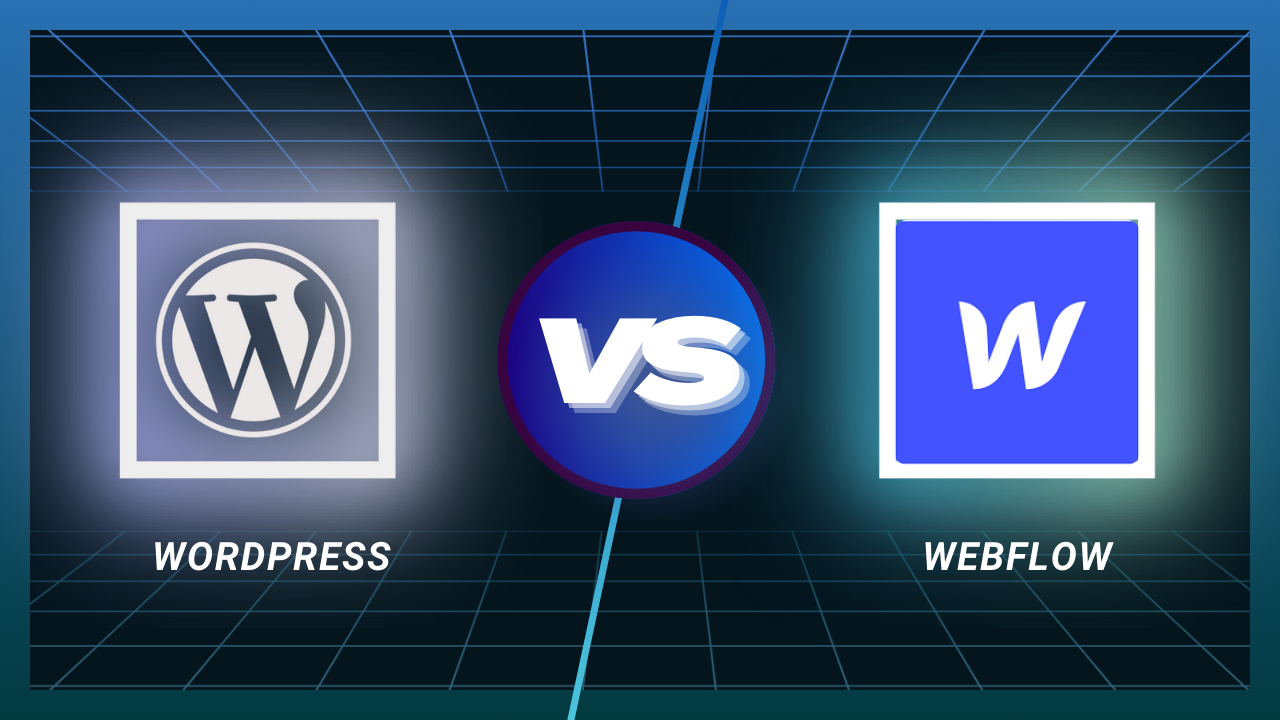If you’re looking to build a website, you’ve probably come across WordPress vs Webflow. Both are powerful tools, but they cater to different types of users. Choosing the right one depends on your skills, goals, and how much control you want over your site.
Imagine WordPress as a versatile toolbox—it gives you the freedom to build anything from scratch, with plenty of customization options. Webflow, on the other hand, is like a sophisticated design studio—it lets you create stunning websites visually, without needing to write code.
What Are WordPress and Webflow?
Before we compare them, let’s first understand what each platform is.
WordPress:
WordPress is an open-source content management system (CMS) that powers over 40% of all websites on the internet. It started as a simple blogging platform in 2003 but has since evolved into a full-fledged website-building tool used by businesses, e-commerce stores, and major media outlets.
One of the biggest advantages of WordPress is its customizability. With over 60,000 plugins and thousands of themes, you can add almost any feature imaginable, from e-commerce stores to membership sites and online courses.
Whether you’re a beginner using drag-and-drop page builders like Elementor or an experienced developer customizing your site with PHP and CSS, WordPress provides endless possibilities.
Key Features:
- Highly customizable with themes & plugins.
- Strong blogging and SEO capabilities.
- Self-hosted (WordPress.org) or hosted (WordPress.com) versions are available.
- Requires some technical knowledge.
- Large support community.
Webflow:
Webflow is a visual website builder that merges the power of coding with an intuitive drag-and-drop interface. Unlike WordPress, which relies on themes and plugins, Webflow allows users to design websites from scratch while still offering the structure of a content management system (CMS). This makes it an excellent choice for designers, freelancers, and businesses looking for creative freedom without complex coding.
One of Webflow’s standout features is its real-time visual editor, where you can see your changes instantly as you build. Unlike other no-code tools, Webflow still generates clean HTML, CSS, and JavaScript, allowing developers to fine-tune their sites if needed.
Webflow also includes hosting, so there’s no need to find a separate hosting provider. With built-in security, automatic updates, and fast-loading performance, Webflow takes care of the technical side while you focus on design.
Key Features:
- Fully visual design experience.
- Built-in hosting and security.
- Automatic backups and updates.
- No plugins required.
- More control over animations and interactions.
What to Look for When Choosing a Website Builder?
Before you choose between WordPress and Webflow, consider these factors:
- Ease of Use – Do you prefer coding or a visual editor?
- Customization & Design – Do you want unlimited flexibility or a simple, guided approach?
- SEO Features – How much control do you need over search engine optimization?
- Pricing – Do you prefer a one-time cost or a subscription-based model?
- Scalability – Will your website grow significantly over time?
- Maintenance – Do you want full control or a hands-off experience?
Now, let’s compare how both platforms measure up in these categories.
WordPress vs Webflow: Comparison Chart
| Feature | WordPress | Webflow |
|---|---|---|
| Ease of Use | Requires some learning, especially for beginners | Visual builder, easier for designers |
| Customization | Highly flexible with plugins & themes | More design-focused, limited third-party integrations |
| SEO | Powerful SEO tools like Rank Math | Built-in SEO features with clean code |
| Pricing | Free (self-hosted), but costs for hosting, themes, plugins | Subscription-based with hosting included |
| E-Commerce | WooCommerce for advanced store functionality | Built-in e-commerce with design flexibility |
| Hosting & Security | Self-hosted, needs external security measures | Managed hosting, automatic security updates |
| Scalability | Suitable for all types of websites, from small blogs to enterprise solutions | Best for portfolios, small businesses, and startups |
| Community Support | Large global community with extensive support resources | Smaller community but growing fast |
Also Reads: WordPress vs Wix
Why Use WordPress?
WordPress is best for bloggers, developers, businesses, and those needing full website control.
Pros of WordPress:
- Highly Customizable – With over 60,000 plugins, you can add almost any feature imaginable.
- Large Community & Support – Since it’s been around for so long, there are tons of tutorials, forums, and professionals to help you.
- SEO-Friendly – Plugins like Rank Math make optimizing your website easy.
- Flexible Hosting Options – Choose your hosting provider to control speed and performance.
- Great for E-Commerce – WooCommerce (a free WordPress plugin) powers nearly 30% of all online stores.
Cons of WordPress:
- Learning Curve – Beginners might find it overwhelming at first.
- Frequent Updates – You have to update plugins, themes, and WordPress itself regularly.
- Security Risks – Being open-source, it’s a target for hackers (but security plugins help mitigate this).
Why Use Webflow?
Webflow is best for designers, freelancers, agencies, and those who want a visually-driven approach.
Pros of Webflow:
- No Plugins Required – Everything you need is built-in, reducing the risk of compatibility issues.
- Beautiful Design Capabilities – Advanced animations, interactions, and responsive design tools.
- Faster Hosting & Security – Webflow includes hosting, SSL certificates, and automatic backups.
- No Coding Needed – You can build visually but still tweak the code if needed.
- Built-in CMS – Great for blogs, portfolios, and e-commerce.
Cons of Webflow:
- Subscription-Based Pricing – Webflow can get expensive as you scale.
- Limited Plugin/Third-Party Support – You’re mostly locked into Webflow’s ecosystem.
- Steep Learning Curve for Beginners – The interface takes time to master.
How to Use WordPress and Webflow?
If you’re new to these platforms, here’s a basic step-by-step guide on how to get started.
How to Use WordPress
- Choose a Hosting Provider – Bluehost, SiteGround, or Kinsta.
- Install WordPress – Most hosts offer one-click installation.
- Pick a Theme – Free or paid options are available.
- Install Essential Plugins – SEO, security, and page builders like Elementor.
- Customize Your Site – Add pages, menus, and widgets.
- Launch & Maintain – Regularly update themes, plugins, and content.
How to Use Webflow
- Sign Up on Webflow – No hosting is needed; it’s included.
- Choose a Template or Start from Scratch
- Use the Visual Editor – Drag, drop, and customize.
- Set Up CMS Collections – Great for blogs, portfolios, and product pages.
- Optimize for SEO – Use Webflow’s built-in SEO tools.
- Publish Your Website – Webflow takes care of hosting and security.
General Statistics: WordPress vs Webflow
Here are some key industry stats to help you make an informed decision:
WordPress Stats:
- 43.2% of all websites use WordPress.
- 64% of CMS-built websites are powered by WordPress.
- WooCommerce powers 30% of online stores worldwide.
Webflow Stats:
- Webflow has over 3.5 million users.
- Used by companies like Rakuten, Discord, Dell, and NASA.
- Webflow websites load twice as fast compared to traditional CMS platforms.

WordPress vs. Webflow: Finding the Best Fit for Your Website
The best platform depends on your specific needs and goals. If you want full customization, flexibility, and scalability, WordPress offers vast plugins and themes to enhance functionality. However, it requires regular updates and some technical knowledge. On the other hand, Webflow is perfect for those who prefer a visually built-in design-focused platform with minimal maintenance. It provides a seamless, code-free experience, making it an excellent option for designers and businesses looking for a hassle-free website. Ultimately, your decision should be based on whether you value complete control or a streamlined, design-friendly approach.
Interesting Reads:
What is WordPress and How Does it Work?
10 Best Software for Document Management
How to install WordPress on cPanel?
Last modified: March 19, 2025



